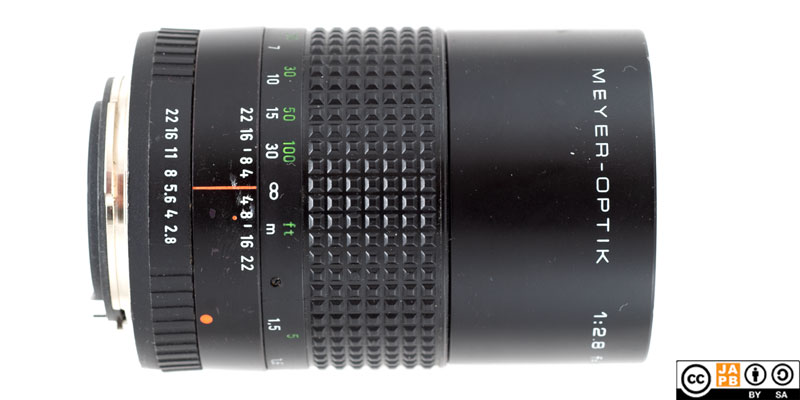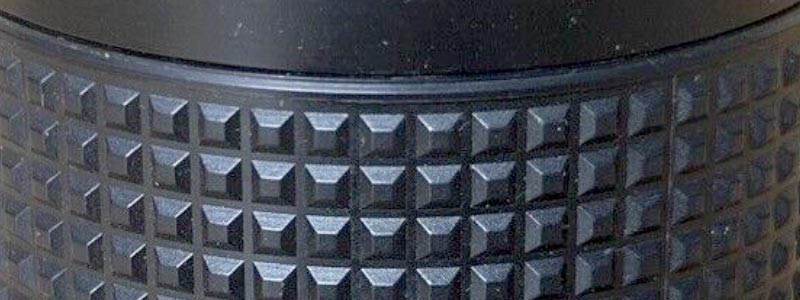Pekka Buttler, 6/2025

Specifications
The table below summarises the lens’ key specifications (measurements based on pictured sample):
| Brand: | Meyer-Optik | Lens name | 1:2,8 f=135mm |
| Focal length(s) 1 | 135 mm | Angle-of-view 2 | 18 ° |
| Maximum Aperture | f/2.8 | In Production | 1990 – 91 |
| Lens mounts | Praktica B | Subfamily (if applicable) | –– |
| Length 3 | 89,5 mm | Diameter 4 | 61,7 mm |
| Filter ring diameter | 55 mm | Weight | 437 grams |
| Lens element count | 5 | Lens group count | 4 |
| Aperture blades (S/R/C) 5 | 6 S | Focus throw | 330 ° |
| Minimum focusing distance (measured) | 151 cms | Maximum magnification (measured) | 1:9,1 |
| Has manual aperture ring | YES | Has Manual focus ring | YES |
| Aperture mechanism type | Automatic | Aperture click stops 6 | 2-8•4•5.6•8•11•16-22 |
Historical notes:
• This lens is simultaneously both very ordinary (indeed: pedestrian) and also rather special.
• On the one hand, this is the same lens as the ‘rationalised’ version of the Pentacon Prakticar 135 mm f/2.8. The Pentacon Prakticar 135 mm f/2.8 made up the long end of the Pentacon triple-kit (28-50-135). The original Pentacon Prakticar 135 and was churned out by the hundreds of thousands, until even East bloc economics was forced to try to come up with ways to cut costs, leading to the development of economised ‘ratio’ variants of bread-and-butter lenses (28-50-135).
• On the other hand, this sample was manufactured after the collapse of the German Democratic Republic (a Soviet satellite state) and carries the name “Meyer-Optik” and proudly proclaims “Made in Germany” (No longer East or West, but unified Germany).
• Given that the Pentacon Prakticar 135 mm f/2.8 itself is a further development of the 1960s Meyer-Optik Görlitz Orestor 135 mm f/2.8 [data sheet]., this Meyer-Optik branded lens does have a certain aura of poetic justice.
• Alas, the 1990s were not gentle to the remnants of East bloc industries, and what was not taken over by western companies was left to crash and burn. • Alike all Praktica B mount lenses, this lens has three electronic contacts that it uses to communicate selected aperture to the camera body and a physical aperture stop-down lever.
Other notes (note that the same applies top all ‘ratio’ versions of the Pentacon Prakticar 135 mm f/2.8):
• The Meyer-Optik 135/2.8 offered a built-in, extendable hood.
• This Meyer-Optik 135/2.8 was offered in the Praktica B lineup alongside remaining stock of Pentacon Prakticar 135/2.8 and the Carl Zeiss Jena Prakticar 135/3.5 [data sheet].
History of Meyer-Optik Görlitz
The original Meyer-Optik Görlitz (not the modern company that has taken the classic company’s name) was founded in the town of Görlitz (modern-day Germany) by Hugo Meyer in 1896, and remained in existence until the state-directed merger into VEB Pentacon 1970. Due to its vicinity with the German camera and optics industries in Saxony (Dresden, etc.), Meyer-Optik was from an early stage heavily involved with manufacturing lenses for all kinds of cameras, but the company’s real golden age started with the advent of interchangeable lens cameras, where Meyer-Optik was uniquely placed to offer a cost-effective alternative to premium brands such as Carl Zeiss Jena.
Meyer-Optik was pronouncedly a camera lens manufacturer and never had serious ambitions for pursuing horizontal integration (diversifying into cameras and other photo gear). Instead, MOG pursued a vigorous strategy of seeking economies of scale, combined with never putting too many eggs in any basket – typically Meyer-Optik would choose which designs to put into production based on being able to cover as many platforms/mounts with one basic design. As a result, many early MOG designs were made available for a wide range of camera platforms. Later, as the number of alternative platforms diminished, that strategy had to go in favour of a strong focus on M42 and (to a somewhat lesser extent) Exakta. Even so, throughout the 60s, MOG vigorously pursued innovative designs and could by the end of the decade proudly offer a wide range of high-quality, cost effective designs.
When the lens maker Meyer-Optik was then merged with the camera maker Pentacon, it became obvious that the role the company (and its product portfolio) was intended to play was to aid Pentacon in its designs of gaining a significant global market share in the price-conscious consumer segment (and help bring hard currency to the G.D.R). Instead of focusing on continued optical innovation, the new overlords were more keen on redesigning lenses for greater economy and easier manufacture. As a result, the pace of optical innovation at MOG/Pentacon fell drastically, and very few new designs or significant redesigns were to be forthcoming in the next two decades.
Meyer-Optik redux (1990-1991)
After the 1989 collapse of East Germany and the 1990 German reunification, some of the remains of VEB Pentacon’s lens business was spun off and reformed as Feinoptisches Werk Görlitz GmbH, which initially started selling remaining Pentacon stocks and lenses assembled from mostly existing parts under the name Meyer-Optik (see: this lens). However, Feinoptisches Werk Görlitz GmbH failed in gaining sufficient financing and was forced to fold in 1991.
Meyer-Optik re-redux (2018–
In 2018 OPC Europe acquires the rights to the name of Meyer-Optik Görlitz (as well as the original 1969 lens designs) and sets out to restart the manufacture of a number of classic designs.
Versions
The Pentacon Prakticar 135/2.8 was produced in two versions. The first version has the typical rubber focusing ring of early Prakticar lenses ( a sample can be viewed here)
The second version used the ‘ratio’ or rationalised design that replaced the rubber focusing ring with with a plastic grip as in the picture below.

Adapting
This lens cannot be used natively on any current SLR or dSLRs. To use it in its native environment, you will need a Praktica B mount film body. Luckily there are a lot of those available, and many of them are still in perfect working order.
Thanks to being a fully manual lens (manual aperture, manual focus), the lens can be adapted to all mirrorless cameras using a suitable adapter. Moreover, Praktica B lenses are so uncomplicated that a simple ‘dumb adapter’ will do the job perfectly (The electronic contacts communicate only from the lens to the camera and do not impinge on adapting). However, due to that the Praktica B mount never was so successful, one should not expect special adapters (helicoid adapters, tilt/shift adapters) to be easily available. Alternatively, one can choose to daisy-chain adapters (e.g. Praktica B->Canon EF; Canon EF –> mirrorless) which not only opens up possibilities for special adapters, but also allows using speed boosters for those photographers that use smaller than full-frame sensors.
Using Praktica B lenses on dSLRs can also be an easy option, depending on which dSLR.
• Canon EF has the shortest flange focal distance among full-frame dSLR’s and Canon’s wide range of dSLRs are able to mount Praktica B lenses perfectly using a suitable adapter ring.
• With other dSLR mounts (Minolta/Sony A; Pentax K; Nikon F) the relationship between flange focal differences becomes an issue, leading to that adapting will necessitate an adapter that uses corrective optics to allow reaching infinity focus.
Footnotes
- Focal length is (unless stated otherwise) given in absolute terms, and not in Full-frame equivalent. For an understanding of whether the lens is wide/tele, see ‘Angle-of-view’. ↩︎
- Picture angle is given in degrees (based on manufacturers’ specs) and concerns the diagonal picture angle. Rule of thumb:
> 90 ° ==> Ultra-wide-angle
70–90 ° ==> Wide-angle
50–70 ° ==> Moderate wide-angle
40–50 ° ==> ‘Standard’ or ‘normal’ lens
20–40 ° ==> Short tele lens
10-20 ° ==> Tele lens
5-10 ° ==> Long tele lens
< 5 ° ==> Ultra-tele lens ↩︎ - Length is given from the mount flange to the front of lens at infinity. ↩︎
- Diameter excludes protrusions such as rabbit ears or stop-down levers. ↩︎
- S=straight; R=rounded; C=(almost)circular at all apertures. ↩︎
- Numbers equal aperture values on aperture ring; • intermediate click; – no intermediate click. ↩︎